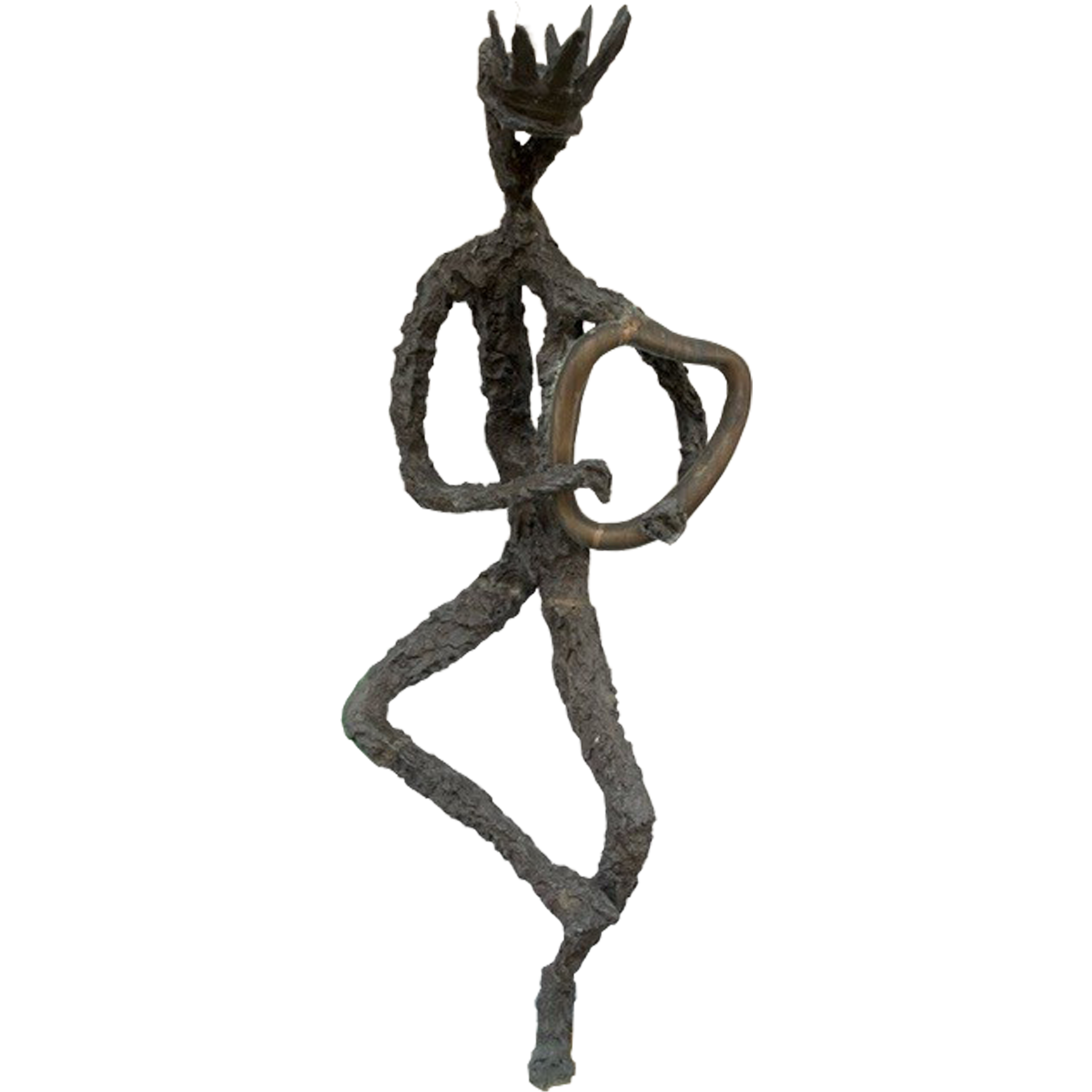
Harry Rosenthal
König David
Bronze, 160 x 70 x 60 cm
Sammlung Klaus Graf von Moltke
Harry Rosenthal’s “King David,” a bronze sculpture, depicts David, the second king of the United Kingdom of Israel. David is integral for establishing a dynasty in Judah where all kings before the Babylonian Exile were descended from him. The Hebrew Bible contains two accounts of David rise in King Saul’s court, one due to his musical prowess (1 Samuel 16) and the other due to his slaying of the Philistine Goliath (1 Samuel 17). After the death of Saul and his son Jonathan, David becomes king over the tribes of Israel. Though an important figure for later Jews and Christians, David’s life is tumultuous, as David commits adultery with Bathsheba, leading to the death of her husband, Uriah. Because David sheds so much blood, and because of his adultery, God denies David the opportunity to build the temple in Jerusalem—a task granted to his son Solomon. Rosenthal’s sculpture may be alluding to David’s tumultuous life as the figure, and his crown are rough. Yet, his harp is made of smooth bronze, contrasting David’s roughness. Not only is David able to soothe King Saul with his music, but nearly half of the Psalms pertain to David (e.g., Psalms 3-9, 11-32), and the Gospels attribute the Psalms to him (Mark 12:36; Luke 20:42).
After the Babylonian Exile removed the institution of kingship from Judea, David was idealized as a monarch, and many Jews hoped for the restoration of the Davidic dynasty. This background is important in contextualizing the figure of Jesus. In all four Gospels, Jesus is called “messiah,” which originally referred to the anointing of a new monarch, and implying Jesus as descendent of David. Sometimes Jesus is called “the son of David” (Mark 1:47-48; Luke 18:38), and both the Gospels of Matthew and Luke contain genealogies tracing Jesus’ lineage back to David (Matthew 1:2-11; Luke 3:23-38). Though the Gospels downplay Jesus‘ crucifixion at the hands of the Romans, and instead blame Jesus’ crucifixion on the Jewish authorities in Jerusalem, historically Jesus’ claim as the descendant of David was most likely seen by the Romans as seditious, thus likely being the cause for his execution by crucifixion. King David and his symbolic import, therefore, provides a crucial background for understanding Jesus’ crucifixion, of which the passion narrative plays a prominent role.
Text by Chance P. McMahon, PhD candidate in Comparative Literature, University of Wisconsin–Madison
Buch des Ursprungs Jesu Christi, des Sohnes Davids, des Sohnes Abrahams: Abraham zeugte den Isaak, / Isaak zeugte den Jakob, / Jakob zeugte den Juda und seine Brüder. Juda zeugte den Perez und den Serach mit der Tamar. / Perez zeugte den Hezron, / Hezron zeugte den Aram, Aram zeugte den Amminadab, / Amminadab zeugte den Nachschon, / Nachschon zeugte den Salmon. Salmon zeugte den Boas mit der Rahab. / Boas zeugte den Obed mit der Rut. / Obed zeugte den Isai, Isai zeugte David, den König. / David zeugte den Salomo mit der Frau des Urija. Salomo zeugte den Rehabeam, / Rehabeam zeugte den Abija, / Abija zeugte den Asa, Asa zeugte den Joschafat, / Joschafat zeugte den Joram, / Joram zeugte den Usija. Usija zeugte den Jotam, / Jotam zeugte den Ahas, / Ahas zeugte den Hiskija, Hiskija zeugte den Manasse, / Manasse zeugte den Amos, / Amos zeugte den Joschija. Joschija zeugte den Jojachin und seine Brüder; das war zur Zeit der Babylonischen Gefangenschaft. Nach der Babylonischen Gefangenschaft zeugte Jojachin den Schealtiël, / Schealtiël zeugte den Serubbabel, Serubbabel zeugte den Abihud, / Abihud zeugte den Eljakim, / Eljakim zeugte den Azor. Azor zeugte den Zadok, / Zadok zeugte den Achim, / Achim zeugte den Eliud, Eliud zeugte den Eleasar, / Eleasar zeugte den Mattan, / Mattan zeugte den Jakob. Jakob zeugte den Josef, den Mann Marias; / von ihr wurde Jesus geboren, / der der Christus genannt wird. Im Ganzen sind es also von Abraham bis David vierzehn Generationen, von David bis zur Babylonischen Gefangenschaft vierzehn Generationen und von der Babylonischen Gefangenschaft bis zu Christus vierzehn Generationen. (Matthäus 1,1—17)

